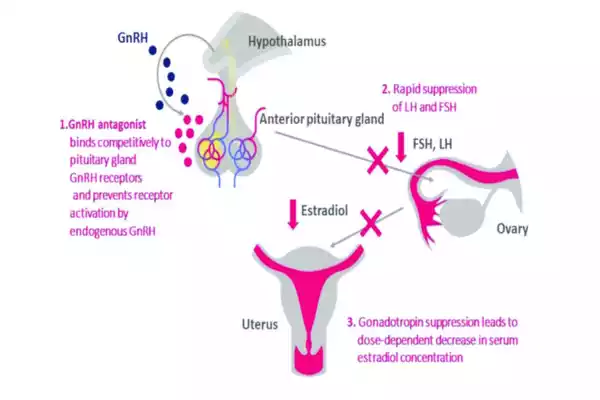GnRH Agonist and GnRH Antagonist are two classes used in reproductive medicine and endocrinology. These drugs are used to regulate hormonal activity. They have different mechanisms of action, and they also have clinical applications.
This article will provide a brief overview of the primary uses and mechanisms for GnRH agonists and GnRH antagonists. Understanding the differences between GnRH agonists and antagonists is important for both healthcare professionals as well as patients who are seeking hormone-related treatments or fertility treatments.
What are GnRH Agonists?
GnRH agonists, or Gonadotropin-Releasing Hormone agonists, are a class of medications used in the field of reproductive medicine and endocrinology. These drugs work by stimulating the GnRH (Gonadotropin-Releasing Hormone) receptors in the brain, ultimately leading to specific effects on the endocrine system.
The primary mechanism of GnRH agonists involves an initial surge in the release of LH (Luteinizing Hormone) and FSH (Follicle-Stimulating Hormone) from the pituitary gland. This initial stimulation is then followed by a paradoxical, sustained suppression of LH (Luteinizing Hormone) and FSH secretion.
This prolonged suppression occurs because of the downregulation of GnRH receptors as a result of continuous GnRH-agonist stimulation. This reduces the production of sex hormones such as testosterone and estrogen.

GnRH-agonists are used in a variety of clinical settings, including:
- Fertility treatments: These are used to improve the success rate of assisted reproductive technologies, such as IVF.
- Treatment of Hormone Sensitive Conditions: GnRH Agonists are used to treat conditions such as endometriosis and uterine fibroids. They can reduce sex hormone production and alleviate symptoms, slowing the progression of these conditions.
- Suppression Of Puberty: GnRH Agonists are used in certain medical conditions such as central precocious puberty to delay puberty onset and prevent early development.
GnRH-agonists can be administered in different forms, such as nasal sprays and injections. These drugs are valued for their ability to temporarily suppress hormonal activity.
GnRH antagonists are medications that initially stimulate the release of LH and FSH but eventually lead to sustained suppression of hormones. These drugs have a variety of clinical uses, including the treatment of hormonal conditions and fertility.
What are GnRH Antagonists?
GnRH antagonists, or Gonadotropin-Releasing Hormone antagonists, are a class of medications used in reproductive medicine and endocrinology. These drugs act by blocking the action of GnRH (Gonadotropin-Releasing Hormone), a hormone produced by the hypothalamus in the brain that plays a key role in regulating the release of other hormones such as LH (Luteinizing Hormone) and FSH (Follicle-Stimulating Hormone) from the pituitary gland.
GnRH antagonists suppress LH and FSH secretion rapidly. GnRH antagonists block GnRH receptors directly and quickly, unlike GnRH agonists which first stimulate hormone release before suppressing it.
This rapid suppression is especially useful in assisted reproduction technologies (ART), such as IVF, where precise control of reproductive cycles is essential.
GnRH inhibitors are used to stop premature ovulation during IVF treatments. This ensures that eggs are collected when they are most fertile. These drugs are used to treat hormone-sensitive conditions such as endometriosis, certain cancers, and other hormonally sensitive conditions.

GnRH antagonists block GnRH action, resulting in a rapid, reversible suppression of LH and FSH production. These medications are often used to treat hormone-related disorders and in fertility treatment.
Between GnRH Agonist and GnRH Antagonist comparison chart
Below is a comparison chart highlighting the key differences between GnRH agonists and GnRH antagonists:
| Aspect | GnRH Agonists | GnRH Antagonists |
|---|---|---|
| Mechanism of Action | – Initial stimulation of LH and FSH release followed by sustained suppression due to receptor downregulation. | – Rapid and direct suppression of LH and FSH secretion by blocking GnRH receptors. |
| Speed of Onset | – Delayed onset due to the initial LH and FSH surge before suppression takes effect. | – Rapid onset with immediate LH and FSH suppression. |
| Clinical Indications | – Fertility treatments (IVF) – Management of hormone-sensitive conditions (e.g., endometriosis, uterine fibroids, prostate cancer) – Delaying puberty in cases of precocious puberty. | – Controlled ovarian stimulation in IVF to prevent premature ovulation – Treatment of hormone-sensitive conditions (e.g., endometriosis, prostate cancer). |
| Administration | – Injections (monthly or quarterly) – Nasal sprays – Implantable pellets (e.g., for prostate cancer). | – Injections – Subcutaneous or intramuscular – Administered during specific phases of IVF protocols. |
| Advantages | – Effective long-term hormonal suppression – Use in various clinical applications – Reversible effects upon discontinuation. | – Rapid and reversible hormonal suppression – Reduced risk of ovarian hyperstimulation syndrome (in IVF) – Precise control of the menstrual cycle during IVF. |
| Disadvantages | – The delayed onset of action – Initial hormonal flare-up may worsen symptoms temporarily (e.g., in endometriosis) – May cause menopausal-like side effects (e.g., hot flashes, vaginal dryness). | – Requires precise timing during IVF – Potential side effects (e.g., injection site reactions, headache, nausea) – Limited long-term applications due to the rapid onset. |
| Cost | – Generally lower cost due to longer-lasting effects. | – May be more expensive, primarily due to the need for precise timing in IVF protocols. |
| Reversibility | – Reversible upon discontinuation, though there may be a delay in the return of fertility. | – Rapidly reversible effects upon discontinuation, allowing for quick restoration of normal hormonal function. |
| Common Examples | – Leuprolide (Lupron) – Goserelin (Zoladex) – Triptorelin (Trelstar) | – Cetrorelix (Cetrotide) – Ganirelix (Ganirelix acetate) |
It’s important to note that the choice between GnRH agonists and antagonists depends on the specific medical condition being treated and the treatment goals. Healthcare providers carefully consider these factors when determining which medication is most appropriate for an individual patient’s needs.
Advantages and disadvantages
Here are some advantages and disadvantages for both GnRH agonists and GnRH antagonists:
Benefits of GnRH antagonists:
- Long-Term Effective Hormonal Suppression: Once the initial LH and FSH flare-up subsides, GnRH antagonists will provide a sustained hormonal suppression. This is useful in treating conditions such as cancers that require long-term hormonal reduction.
- Wide Range of Clinical Applications: GnRH-agonists are used in a variety of clinical settings, such as the treatment of endometriosis and uterine fibroids. They can also be used for fertility treatments, like IVF.
- Reversibility: Although there may be some delay in returning to fertility, GnRH-agonists can generally be stopped without causing any adverse effects. This is important, especially for patients who are seeking fertility treatment.
The disadvantages of GnRH antagonists:
- Delayed Action: The release of LH or FSH is initially stimulated by GnRH antagonists, which may cause temporary symptoms to worsen in certain conditions.
- Side Effects Similar to Menopause: These drugs can cause side effects similar to menopause including hot flashes and vaginal drying.
- Exacerbation Potential of Symptoms: In certain hormone-sensitive conditions, the initial hormonal flare caused by GnRH Agonists can temporarily worsen symptoms before the desired suppression is achieved.
Benefits of GnRH antagonists:
- Rapid Suppression and Immediate: GnRH antagonizers suppress LH and FSH quickly and directly without the initial hormonal rush, making them useful in situations that require rapid suppression.
- Reduced risk of Ovarian hyperstimulation syndrome (OHSS): GnRH antagonists in IVF protocols are preferred to reduce the risk of OHSS. This is a potentially serious complication.
- Precise control in IVF: GnRH antagonizers allow precise control of menstrual cycles during IVF. This ensures that ovulation happens at the best time for egg extraction.
The disadvantages of GnRH antagonists:
- Exact Timing Required: GnRH Antagonists are administered at specific times in IVF protocols. This makes them less flexible than GnRH Agonists.
- Side Effects: Although generally well tolerated, GnRH antagonists can cause side effects, including headaches, nausea, and injection site reactions.
- Limited Use Long-Term: GnRH antagonists are used primarily for short-term hormonal suppression and may not suit conditions that require prolonged suppression.
The choice of GnRH antagonists or agonists is dependent on the medical condition and treatment goals. When making treatment decisions, patients and healthcare providers must carefully weigh the advantages and disadvantages.
Conclusion
GnRH and GnRH Antagonists are both essential medications, but they have different mechanisms and applications. GnRH antagonists are effective for long-term hormonal suppression, but they have a delayed onset as well as menopausal side effects.
GnRH inhibitors suppress ovaries quickly, which makes them perfect for IVF. However, they require precise timing and are best used for short periods of time. It depends on your condition and the treatment goals. This is why it’s important to make informed clinical decisions.

